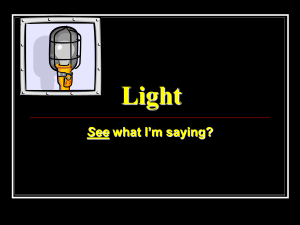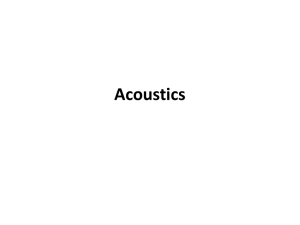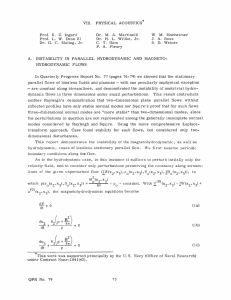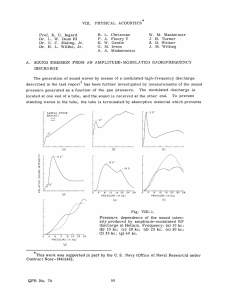M. A. Martinelli
advertisement
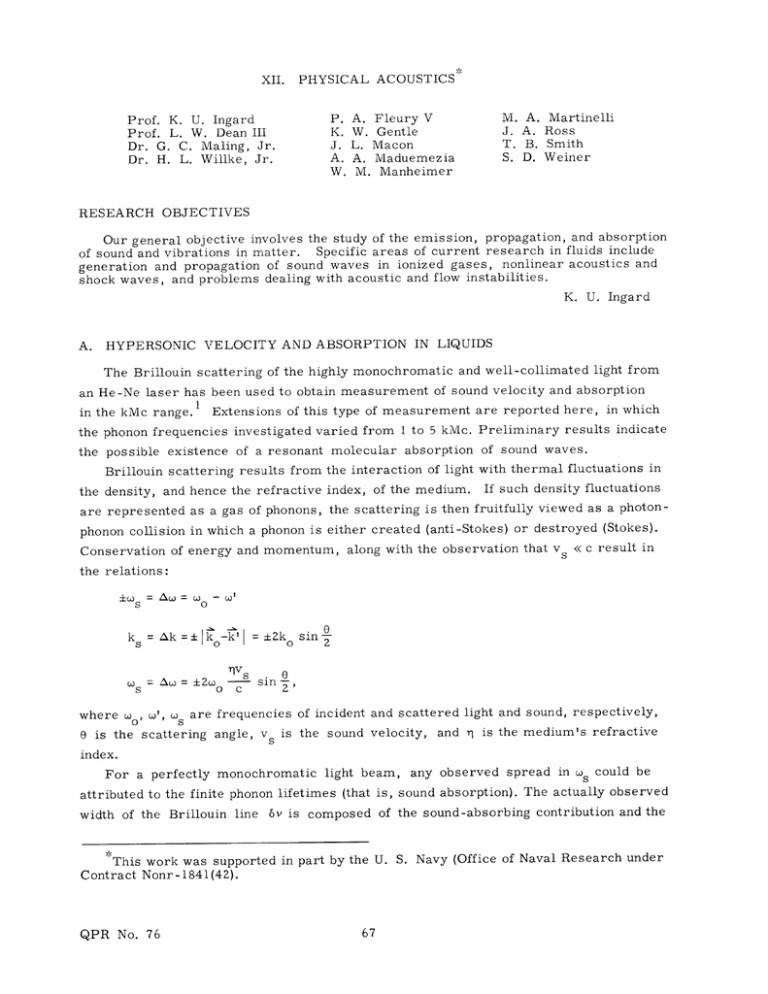
XII. PHYSICAL ACOUSTICS Prof. K. U. Ingard P. A. Fleury V Prof. L. W. Dean III Dr. G. C. Maling, Jr. Dr. H. L. Willke, Jr. K. J. A. W. RESEARCH M. A. Martinelli J. A. Ross T. B. Smith S. D. Weiner W. Gentle L. Macon A. Maduemezia M. Manheimer OBJECTIVES Our general objective involves the study of the emission, propagation, and absorption Specific areas of current research in fluids include of sound and vibrations in matter. waves in ionized gases, nonlinear acoustics and sound of propagation and generation shock waves, and problems dealing with acoustic and flow instabilities. K. U. A. Ingard HYPERSONIC VELOCITY AND ABSORPTION IN LIQUIDS The Brillouin scattering of the highly monochromatic and well-collimated light from an He-Ne laser has been used to obtain measurement of sound velocity and absorption in the kMc range. 1 Extensions of this type of measurement are reported here, in which the phonon frequencies investigated varied from 1 to 5 kMc. Preliminary results indicate the possible existence of a resonant molecular absorption of sound waves. Brillouin scattering results from the interaction of light with thermal fluctuations in the density, and hence the refractive index, of the medium. If such density fluctuations are represented as a gas of phonons, the scattering is then fruitfully viewed as a photonphonon collision in which a phonon is either created (anti-Stokes) or destroyed (Stokes). Conservation of energy and momentum, along with the observation that v s <<c result in the relations: s k 0 = Ak = w s where w, o Aw = ', o 2w -k'I = ±2k 0o sin - 2 o - c sin- 2 s1 are frequencies of incident and scattered light and sound, respectively, is the scattering angle, vs is the sound velocity, and T1 is the medium's refractive index. For a perfectly monochromatic attributed to the finite phonon lifetimes (that is, width of the Brillouin line 6v is any observed spread in Ws could be light beam, sound absorption). The actually observed composed of the sound-absorbing contribution and the This work was supported in part by the U. S. Contract Nonr- 1841(42). QPR No. 76 Navy (Office of Naval Research under (XII. PHYSICAL ACOUSTICS) frequency spread of the maser. These widths are additive if Lorentzian line shapes are assumed. 6v = 6v The relation n + 6v s a 2- l- s the sound wavelength, determines the sound absorption coefficient as, where s s is s and Av is the interorder spacing of the Fabry-Perot interferom- eter. The experiment is schematically represented in Fig. XII-1. of the Fabry-Perot results in a recorder output such as appears in Fig. these experiments the maser width was ~720 Mc, temperature was the maser power, 22-230C resulting in a spread of velocities of of lack of temperature control. The 2 METERPRECISION OPTICAL RAIL F = 25 CM F = 36 CM RCA 7326 n CYLINDRICAL XII-1. - \ PHOTOTUBE VACUUM ANGON \ PRESSURE-SCANNING FABRY-PEROT INTERFEROMETER VARIAN MILLIVOLT RECORDER Experimental apparatus. The maser is linearly polarized perpendicularly to the scattering plane. INTERORDER SPACING BRILLOUIN ±1. 0 per cent because light from an adjustable mirror ) SCATTERING CELL MASER BRILLOUIN 0.25 CM BRILLOUIN -1 MASER BRILLOUIN Fig. XII-2. Recorder trace of spectrum in acetic acid at 0 = 600; T = 230C. QPR No. 76 For 10-20 mW. The ADJUSTABLE MIRROR He3- Ne MASER Fig. XII-2. variation of the angle 0 and hence of the fre- quency wo s was achieved by reflecting the incident (6328 Slow pressure scanning (XII. mounted on a moveable spectroscopic table. The angles PHYSICAL ACOUSTICS) could be measured to better than 0. 10. Because of the magnitude of the maser linewidth and variations in the maser power, the accuracy of absorption measurements is no better than ~10 percent. quencies (~5 kMc), however, absorption is At such fre- so high that conventional ultrasonic (prop- agation) techniques could not be expected to serve very well. The accuracies in this experiment could be improved by narrowing the maser width, using lock-in detection, and increasing the finesse of the Fabry-Perot interferometer. VELOCITY - 1.0 1200 E 1150 ~ -- 0.9 z 1100 0 ABSORPTION u 1050 0.8 $ 0 1000 950 1 3 2 4 SOUND FREQUENCY (kmc) Fig. XII-3. Hypersonic velocity and absorption in acetic acid. Measured values of absorption coefficients and speed of sound for acetic acid are presented in Fig. XII-3. Salient features are the nonmonatomic behavior of velocity, the peak in the absorption at ~175 kMc, and the correspondence between absorption and velocity data, which would be expected from Kramers-Kronig relations; however, on account of the magnitude of the error, caution should be exercised in interpreting these results. Departure observed from classical absorption and velocity dispersion in liquids has heretofore been of the relaxational type.2 Our results indicate the possibility of a res- onant molecular sound-absorption mechanism. Refinements of apparatus and technique are under way, and reduction of experimental errors will make possible more definite conclusions regarding resonances. best, Meanwhile, Brillouin scattering stands out as the and sometimes the only, technique for studying the propagation characteristics of kilomegacycle sound. QPR No. 76 PHYSICAL ACOUSTICS) (XII. This was experiment jointly with performed R. Y. Chiao, M. I. T. , which is under the direction of Professor C. Group, of the Optical Maser H. Townes and Professor A. Javan. P. A. Fleury V References 1. R. Y. Chiao and B. P. Stoicheff, J. Opt. Soc. Am. 54, 1286 (1964); G. B. Benedek, J. B. Lastovka, K. Fritsch, and T. Greytak, J. Opt. Soc. Am. 54, 1284 (1964). 2. K. F. Herzfeld and T. A. Litovitz, Absorption and Dispersion of Ultrasonic Waves (Academic Press, New York, 1959). B. LONGITUDINAL WAVES IN A WEAKLY IONIZED GAS We have reported elsewherel on an experiment in which the neutral gas temperature in the plasma column of an argon discharge was determined from sound-velocity measurements with Langmuir probes used as acoustic detectors. The analysis of the data obtained was based on the assumption that the measured wave velocity was the same as that in un-ionized argon. In the present report the validity of this assumption is investigated by an analysis of the different longitudinal modes that can exist in the weakly ionized gas. This analysis is based on the following set of linearized equations of motion in which the subscripts n, i, and e refer to the neutrals, the ions, and the electrons, respectively. atn n + = 0 Nav -1 n e ne n ni(i n axn 8tvn atn. + Niaxvi = 0 -1 + plap tv t 1 1 = in (Vn-v xi in i) (1) atn e + Ne 8 v -1 Sv e + P e 8axp e t = = 0 en (v--v) - (q/m e)e + en n X 2 cmn n nn l 2 p. = c.m.n. 1 1 11 The research of this group is Space Administration. QPR No. 76 e e a e = 4rq(n.-n ), pn ie (ve-vi) e + (q/mi)e + N. = N 1 p ei(vi-ve ) ei 1 e e e 2 =cmn. e ee supported in part by the National Aeronautics and (XII. Here, PHYSICAL ACOUSTICS) flow N stands for particle density; p, v, n, and e are perturbations in pressure, velocity, density, and electric field, respectively; particle mass; and p =Nm is the density. q is the electronic charge; m is the The coupling between the three fluid com- ponents is expressed by the collision terms on the right-hand side of the momentum The collision frequencies involved are related as follows: equations. Wne = (Neme/Nnmn) en' ni = (Nmi/Nm n)win (N/Nn)win (2) win = /me/mi)we . Under the conditions of interest here, with gas pressures of the order of 1 Torr and 10 -3 electron densities of the order of 1010 cm , we find that the frequencies wni and wne ei are of the order of 10 5 or larger, and and en, Win, less, or unity approximately are 2 -1 The plasma frequencies for the electrons and the ions, w. is of the order of 10 sec -1 le , respectively. Thus, within the free and w i , are of the order of 1010 and 108 sec quency range of interest here, between 10 and 10 5 , we have (ne ni) i Since the basic object of this analysis is to investigate the influence of the collisions between the neutrals and the charged particles on the acoustic-wave mode, we have not included viscous stress terms in the momentum equation, or the influence of heat conduction. Accordingly, the pressures pn, pi', and p have been set proportional to the respective densities, with the constant of proportionality c essentially being the inverse 2 of the compressibility of the various components, c = 1/ pK. The dispersion relation for plane waves resulting from the equations of motion indicates the existence of three longitudinal wave modes. The first mode with the dispersion relation k = (3) /cn is the ordinary sound wave that travels with the sound speed of the neutral gas, cn. There is no damping resulting from n-i and n-e collisions which is of any consequence in comparison with the ordinary damping caused by viscosity and heat conduction. pointed out that to obtain the correct damping terms and eigenvectors, it is essential to ne/w and defer approximations until calculations ne 2 In this acoustic mode all Otherwise there may be misleading results. keep all terms of the order of are completed. (It should be .ni/ and three fluid components have the same amplitude and move in phase with each other, the relative change in density for all components is the same. and Since they all move to- gether, there is no momentum transfer from one component to the other. The second mode with the dispersion relation 2 k2 k 2 o (4) + i a can be regarded as a degenerate ion acoustic wave. QPR No. 76 In this mode the ions and the (XII. PHYSICAL ACOUSTICS) electrons move in phase with each other with the same amplitude, and the neutrals can Actually, the velocity amplitude of the neutrals is of the be considered to be at rest. order of N./No,that is,negligible compared with the amplitude of the charge components. The wave amplitude decays within one acoustic wavelength. The third mode is a degenerate plasma oscillation with a dispersion relation k2 = (w/c )2 ne (e + en in + i(T . /wT.)(Ti/T), (7) in or k e cn n i T e " In this mode the neutrals are approximately stationary, and the ions and electrons move in opposite directions with the same amplitudes. The wavelength is of the order of the Debye length, and the motion is overdamped. Our analysis has shown that of the three possible longitudinal modes only the acoustic mode will propagate without significant attenuation through the ionized gas, and that the presence of charged particles does not influence the speed and attenuation of this mode. The collisions are sufficiently frequent to "freeze" the ions and electrons to the neutrals in this wave mode. The two remaining modes are strongly damped and should attenuate within approximately one wavelength of the sound wave and a Debye length, respectively. K. W. Gentle, K. U. Ingard References 1. K. W. Gentle and U. Ingard, Appl. Phys. 2. G. M. papers. C. Letters 5, 105 (1964). Sessler, Phys. Fluids 7, 90 (1964) contains references to other relevant COUPLING OF DIFFUSION AND PRESSURE WAVES IN A WEAKLY IONIZED GAS An attempt will be made to explain stationary striations in the positive column of a gas discharge in terms of coupling of diffusion and pressure waves. In this analysis, the electrons are assumed to diffuse infinitely rapidly relative to the ions and form a uniform negative background. in the quantities n, v, and e, and longitudinal electric field. equations are used: = yNe nt + Vnx x + Nvx x QPR No. 76 The equations of motion for the ions are then linearized representing the perturbations in ion density, ion velocity, Transverse variations are neglected and one-dimensional (XII. e x PHYSICAL ACOUSTICS) = qn (2) qe Nq - E - -n 2 + c n Nv t + NVv = (3) 0 where V is the ion drift speed, N is the unperturbed ion density, q is the electronic charge, E is the unperturbed electric field, c is the ion sound speed, and y is aZ/aE, where Z is the ionization rate. Combining Eqs. 1-3 gives an equation for n: 2 ntt x + 2Vn ttx txx 22 - ( -V)n xxx Nq +- - yqN(n +Vn) t x m n + i x V T.1 n xx =0, (4) and a dispersion relation 2 where T. 1 Z 2 - 2V~k - (c -V)k - yqN k (wo-Vk) - Nq2 is the ion-neutral collision time. m - V i-k T. 1 = 0, The term, Nq /m, (5) is the square of the ion plasma frequency, while the imaginary term, iVk/Ti, produces damping of the waves. From Eq. 5, the group velocity is found to be c2 V =V - (V 2) - (VJ2) + i(V/2Tik) ± , (6) gr c 2 + (VD2) 2 + (Nq2/mk2) + i(V/Tik) 2 It is expected that stationary striations will be observed with values of k corresponding to Vg = 0. It might be mentioned that Vph = 0 for k of the same order of magnitude. Before attempting to solve Eq. 6 to find k when Vg r = 0, it where VD = yqN/k . is advantageous to consider the orders of magnitude of the various velocities entering into Eq. 6. We shall find an approximate solution of Eq. 6 for an Argon plasma. In this case, the terms c dropped. Thus , VD, and V/Tik are kept, while the terms V , and Nq /mk are c2 - (VJ2)2 + i(V/2Tik) (7) Vg r = -VD/2 gr c 2 + (VD2) 2 + i(V/Tik) Since we are interested in observing stationary striations, we require that Re (Vgr) = 0, but we do not impose any conditions on Im (V gr). It is convenient to consider the solution to Eq. 7 in the two limiting regions, c >>V/Tik and c2 < V/Tik. Case 1: c 2 >>V/.k Making this approximation in Eq. 7 gives QPR No. 76 (XII. PHYSICAL ACOUSTICS) c2 - (V 22 2 ± Re (Vgr) = -V (V + terms ) of order V/.k VD = r ) c. c c2 + (VJ2)2 This has Re (Vg 2 = 0 when 4-3 c . This yields values of k of the same order of magnitude as experimental values (k~10). Case 2: c <<V/Tik This case is of special interest, as it corresponds fairly well to the experimental situation and shows also the behavior of the solution as the ion temperature goes to zero. Setting c = 0 in Eq. 7 gives -(VD/2) 2 + i(V/Zrik) Vgr = -VD/2 2 (VJ2) + i(V/Tik) Equation 9 is solved by setting (V _ V gr 2) 2 = A(V/Tik) to give /V/T. k ,A 2 +11 J [-NA 2 + 1 ± (-A+i/2) Substitution of numerical values for A in Eq. occurs for A between 0 and 0. 1. A << 1 and find that Re (Vg r - NI A--7] (10) 10 shows that the solution Re (V g r ) = 0 We use this information to make the approximation = 0 for ) ± (-A/ N2 + 1/2N[ = 0, (11) with the (positive) solution A = 3/2 - ,Fi = 0. 086. Substituting (12) in (V2)2 3 (12) = (yqN/2k2) 2 = A(V/Tik) gives for k (yqN)Zm (yqN) T i .344V In estimating orders of magnitude, (kh)3 94 mV qEh (13) .344qE 2 we approximate y = dZ/dE by Z/E. 4 (kTe/qEa) ~ mV e 2 /qEh, We thus obtain (14) where h is the Debye length, kTe/q is the electron temperature in volts, and a is the QPR No. 76 (XII. column radius. PHYSICAL ACOUSTICS) -1 Putting in typical values for the parameters in Eq. 14 gives k ~ 10 cm-1 which is in agreement with experiment. It should be pointed out that, although the values of k obtained in cases 1 and 2 are of the same order of magnitude, the waves in these cases differ considerably. Im (Vgr) = 0 and the waves are undamped; in case 2, Im (Vgr) # In case 1, 0 and the waves are damped. It should also be mentioned that the condition Re (Vgr) = 0 does not insure that stastionary striations are observed. In the case of plasma oscillations, V gr = 0 for all k, but striations are not observed. The fact that Re (Vgr) = 0 for only one particular k, indicates, however,that if striations are observed, they should have this wave number. S. D. Weiner, U. Ingard D. INSTABILITY IN TIME-SYMMETRIC FLOWS If a physical system is to appear stable against external influences, the effects of initial disturbances should not become arbitrarily magnified; in fact, eventually they must become unobservably small. It should be clear that given a system and its image under time reversal, one at most can appear stable, since the decay of an arbitrarily large initial disturbance of one system to an unobservably small level appears in the reversed system as the growth of initially unobservably small disturbances to an arbitrarily large level. unstable. In particular, a system symmetric under time reversal must be These considerations evidently apply to any reversing transformations that preserve disturbance systems connected by time- "strength" (energy, maximum amplitude or other norm) at corresponding times. Systems unstable by symmetry are to be found among common subjects of stability theory, notably the inviscid parallel fluid flows. We shall exhibit here symmetric fluid and plasma flows together with their implemental transformations. Solutions of the dissipation-free Navier-Stokes equations with arbitrary spatially and temporally homogeneous equations of state are apparently closed under the following transformations, with arbitrary origins for t and x. Time reversal t - -t v - -v P.: Spatial reflection 1 x. - -x 1 1 v. -t-v. 1 1 (Note that T and the P. clearly preserve relevant "strength" criteria, including the L 1 p norms.) Our instability criterion applies to flows that, together with their associated boundary QPR No. 76 (XII. PHYSICAL ACOUSTICS) conditions, are invariant under a composition of T and the P.. cation of T alone is to static equilibria, whereas P3 P 2 3T, and P dynamic situations with symmetric boundaries and streamlines. two dimensions is not necessarily determined by its The most obvious appli- streamline 3T apply to 1 (Flow in more than pattern, so that we should specify also the symmetry of the scalar dynamical variables.) In particular, P3 T (i) t - -t x 3 - -x 3 j#3 v. -- v, leaves invariant stationary or otherwise time-symmetric flows with streamlines symmetric in x 3 , including any parallel flow of the form V = E 3 W(x 1 , x ), in which W may be discontinuous (tangential shocks), or such flow altered by the introduction of objects P3T also transforms normal shocks with higher pressure behind the shock into normal shocks with higher pressure ahead of the shock, which shows that at symmetric in x 3 . least one type is unstable. t - -t P 2 P3 T: 223 (ii) x 2 -- x2 x3 - -x 3 v 1 - -v to time-symmetric flows in three spatial dimensions invariant under 1800 rotation about the xl axis, including that over rotation-symmetric wings and airfoils, or such flow modified by steadily rotating fans and propellers with such symmetry applies at t = 0. (iii) PT = w.P.T 11 t - -t x - -x leaves invariant symmetric flow over a yawed tipped flat rectangular plate or other object symmetric through the origin. The addition of B.1 - -B. 1 to the P. 1 extends these transformations to encompass perfectly conducting plasmas. Another invariance property, Charge conjugation C: B - -B j---j also appears. current profiles QPR No. 76 All equilibrium and boundary plasma configurations, regardless of field and conditions, are symmetric under T itself, and hence (XII. Dynamic unstable. fluid flows plasma are to be situations handled PHYSICAL ACOUSTICS) after the fashion discussed above. H. L. E. of the Willke, Jr. SHOCK-WAVE TRANSMISSION AND ATTENUATION A longer driver for the shock tube described in a previous report1 has been constructed. Also, a new microphone system has been installed which has a frequency Fig. XII-4. Pressure signature of a shock wave incident on the end of the tube. Horizontal sweep speed -0. 2 msec/cm. Fig. XII-5. Decay of a shock wave in the tube. Horizontal sweep speed -2 msec/cm. ATTENUATION RATE =0.12 db/ft ATTENUATION RATE= 100 200 TRAVEL DISTANCE AFTER INITIAL REFLECTION (ft) Fig. XII-6. QPR No. 76 Shock decay rate as a function of travel distance. (XII. PHYSICAL ACOUSTICS) response from 0 to 10 kc, and allows us to measure pressures up to 100 psi. A static- pressure gauge can therefore be used for calibration. Experiments with the new system have confirmed the data presented previouslyI on the pressure reduction produced by a fine screen in the tube. A typical photograph of the pressure signature measured at the end of the tube (closed) is shown in Fig. XII-4. The wall pressure produced by this shock wave is 32 psi. Some measurements have also been made of the decay of a shock wave as it is reflected from the closed ends of the tube. Here, the incident pulse is too Some typical results are shown in Fig. XII-5. large to be seen on the screen, but its amplitude was obtained from other photographs. The decay of the wave must be calculated from a measurement of pressure at the end of the tube because the nonlinear interaction of the incident and reflected waves must be taken into account. Some preliminary decay data have been calculated from this pho- tograph, and are shown in Fig. XII-6. The decay rate is faster than that calculated for repeated shock waves in free space.2 G. C. Maling, Jr., U.- Ingard References 1. G. C. Maling, Jr. and U. Ingard, Quarterly Progress Report No. 75, Research Laboratory of Electronics, M. I. T., October 15, 1964, pp. 42-44. 2. I. Rudnick, J. QPR No. 76 Acoust. Soc. Am. 25, 1012 (1953).

